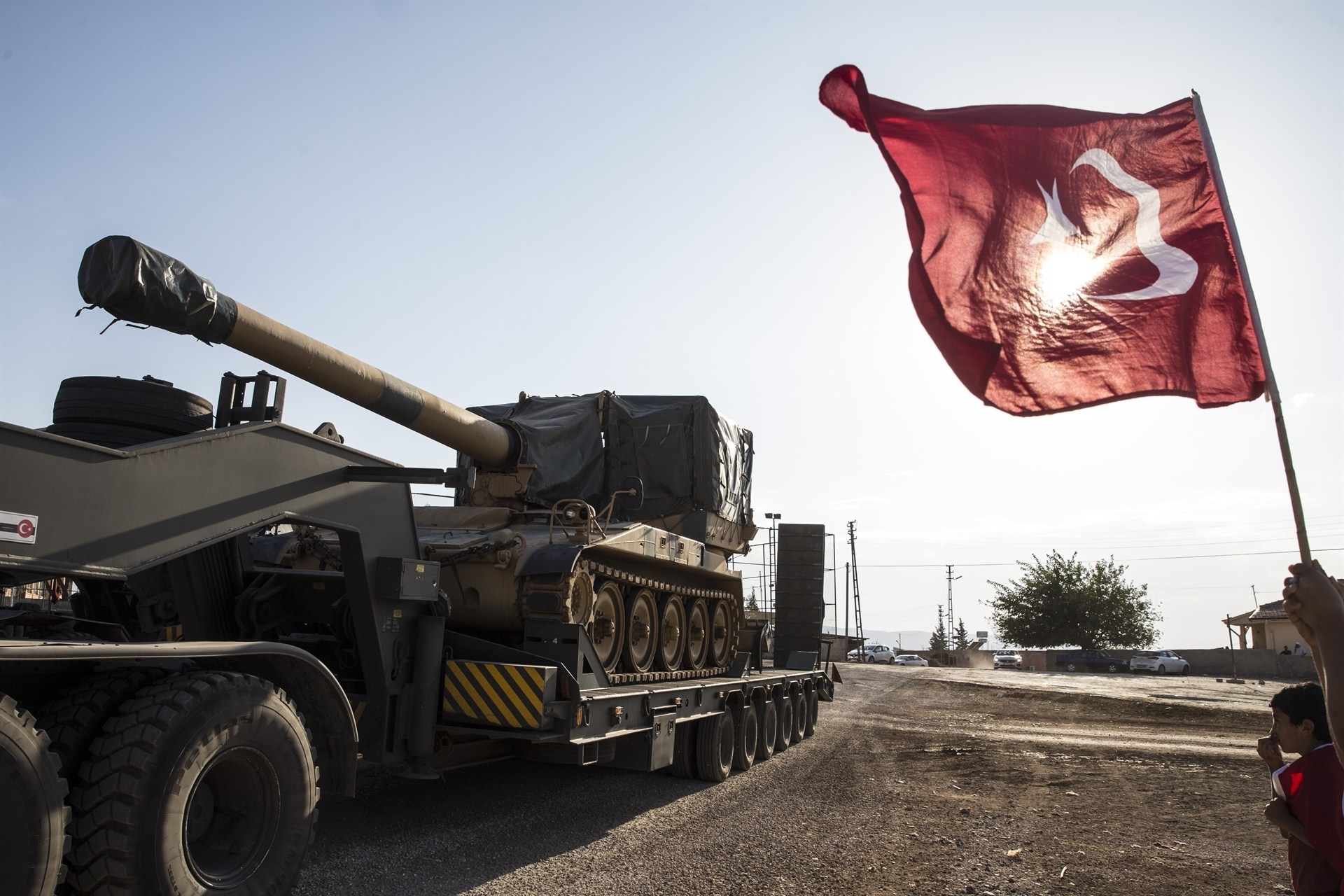[authorbox authorid=”32″ ]
[dropcap size=big]O[/dropcap]n 12 December Turkish President Recep Tayyip Erdogan announced that Turkish forces would within days launch an offensive aimed at clearing northern Syria east of the Euphrates from separatist terrorists eg the Kurdish People’s Protection Units (YPG).
In recognition of the presence of US forces in the area, he added that ‘our target is never US soldiers’. Erdogan also dismissed claims that an IS threat persisted in Syria as a ‘fantasy’.
There were reports in Turkey of troop movements towards the border, and of sections of the border wall being removed. A spokesman for the Turkish-backed umbrella group of rebels, the so-called National Army, declared that it would contribute to the Turkish offensive. Recent weeks have featured a number of incidents of cross border fire against the YPG from across the Turkish border. Within a few days, and perhaps to reinforce the message, Turkish planes launched bombing raids against PKK targets in Sinjar and Makhmur in northern Iraq. Should an offensive into eastern Syria go ahead, Arab majority areas such as Tal Abyad, and border locations such as Kobane, would appear to be particularly vulnerable, although some have doubted that Turkey has sufficient forces in the area to move far beyond the border. At the same time, it is not a foregone conclusion that US and other western forces in the area could offer much resistance, should it come to that.
Washington was clearly rattled. A Pentagon spokesman said that ‘unilateral military action into northeast Syria by any party, particularly as US personnel may be present or in the vicinity, is of grave concern’, and that any such attack would be ‘unacceptable’.
The US reiterated that it regarded the YPG as a ‘committed partner’ in the fight against Islamic State (IS) in Syria, and that any attack on it would detract from the struggle against IS, as allegedly happened following Turkey’s invasion of Afrin in January 2018.
In fact the YPG-led Syrian Democratic Forces (SDF) has for weeks been conducting a difficult and bloody campaign against the IS-held town of Hafrin, in Deir-ez-Zor province on the banks of the Euphrates near the Iraqi border, where the US estimates that up to 2000 IS fighters are located. As Erdogan spoke, it was on the very verge of victory.
The region east of the Euphrates is mainly in the hands of the YPG-led Syrian Democratic Forces (SDF), although there have been occasional clashes in the region with regime forces.
There are reckoned to be at least 2000 US and a few hundred French military personnel there, and possibly some UK Special Forces too. The SDF-controlled area in eastern Syria, centred on the largely Kurdish-inhabited towns of Hasakah and Qamishli but also including the now highly symbolic town of Kobane, is the jewel in the crown of the Kurdish-dominated but multi-ethnic Democratic Federation of Northern Syria (DFNS), formerly known as Rojava.
The DFNS’s western outpost, Afrin, was taken from the YPG by Turkish-led forces in early 2018, although the YPG is conducting an irregular campaign against the Turkish presence there. The region east of the Euphrates was largely acquired by the YPG, with US assistance, during 2014 and 2015, in the aftermath of the US-assisted lifting of the IS siege of Kobane, a battle which Turkey was content to passively observe. It has since emerged as more stable than many other parts of Syria, and the Kurdish Democratic Union Party, or PYD, has been steadily building a Kurdish self-governing entity based on Abdullah Ocalan’s principles of ‘democratic confederalism’.
Given the YPG’s links to the PKK, these developments are seen in Turkey as an existential threat. The introduction of joint US-YPG patrols along the Syrian border with Turkey, and the still more recent establishment of five US border observation posts, have generally been interpreted by Ankara as aimed at protecting the Syrian Kurds from Turkish attacks, notwithstanding some quite woolly denials from the Pentagon. Washington’s recently-announced programme to train up to 40000 SDF soldiers, a force which it has in any case been arming and training for years, has further provoked Ankara, which regards it as a strengthening of the PKK.
With the construction of around a dozen US bases in the region, and increasing talk in Washington of a long stay both to combat Iranian influence in Syria and to ensure a role in any Syrian peace process, Turkey fears that the US-YPG collaboration might endure for some time, which could provide an umbrella beneath which the Kurds can consolidate their self-governing entity along eastern Syria’s border with Turkey– and with some of its predominantly Kurdish inhabited areas – as well as with the Kurdistan Region of Iraq (KRI).
Even so, eastern Syria is not Afrin. In addition to the western presence there, any Turkish infringement will not occur in the context of a green light from Moscow, as was the case in Afrin.
Furthermore, YPG forces are far more entrenched than was the case in its western outpost. Indeed, some interpreted Erdogan’s escalation of the rhetoric in the context of the local elections due in Turkey at the end of March, in the expectation of tapping into nationalist sentiment. Such behaviour on Erdogan’s part is familiar.
On the other hand, Turkey did conduct offensives both in Afrin and, before that, towards Jarablus and Aziz, in order to prevent the YPG’s establishment of a contiguous zone of control along northern Syria’s border with Turkey.
Furthermore, the Afrin operation was preceded by Turkish cross-fire attacks similar to those that have recently taken place east of the Euphrates.
It seems too that Turkey has conducted clandestine operations in eastern Syria, and has sought to recruit local non-Kurdish forces. In any case, it is hard to square the ferocity of Ankara’s rhetoric against the Kurdish-run entity in eastern Syria with an unending passivity towards its existence.
Erdogan has often cried wolf, and has indeed threatened military action against the YPG in eastern Syria before, but he has also shown himself capable of seemingly reckless risk-taking.
There can be no doubt that Ankara is very frustrated with the US in Syria and with the relationship it has established with the YPG. In recent months this tension has mainly manifested itself in Manbij, a multi-ethnic town just west of the Euphrates that was taken from IS by the SDF in a fierce fight during the summer of 2016.
It forms part of the DFNS, and serves as a hub for US-led coalition training of YPG forces. Much of Ankara’s resentment at the US-YPG alliance has focused on Manbij, which has been constantly threatened by Turkey-backed rebel forces.
In June 2018 the US and Turkey agreed a ‘road map’ which Ankara hoped would lead to the removal of all Kurdish forces in the town and in due course hand its security over to the US and Turkey. In fact the largely Arab Manbij Military Council (MMC) has governed Manbij since 2016, but Turkey has continued to insist that Kurds hold the upper hand in practice. Such was the distrust between the two NATO allies that joint US-Turkish patrols on the edge of the city did not get under way until November 2018, with the US continuing to deny that Turkish forces would be allowed into the town itself. Ankara’s dissatisfaction has not been appeased, and it maintains that the YPG presence in Manbij has not ended. In fact November saw a number of attacks by Turkey-backed forces on MMC military positions, some of them in locations close to the US-Turkey patrols. There is as yet little sign that Ankara trusts the US in Manbij, notwithstanding American reassurances.
Even if once can sympathise with Ankara’s apprehension at Kurdish gains in Syria, it is unclear what Erdogan hopes to gain by annoying Washington or quite what it intends to do with the Syrian territories in which it is already present, Idlib and Afrin.
If it hopes to wean Washington away from the PYG and towards itself, it will need to demonstrate more enthusiasm for the battle against IS than it has thus far manifested. And it will need too to present itself as more reliable partner than it seems bent on doing, given the range of difficulties currently confronting the Ankara-Washington relationship.
Furthermore, it is far from clear that Turkey would benefit from a US withdrawal from Syria. It would leave the field open to Iran and Russia – and Moscow too has frequently expressed a preference for Kurdish involvement in any Syrian peace process and even for a federal solution. And it would leave Turkish forces in Idlib and Afrin as the only substantial foreign forces whose presence is rejected by Damascus. Turkish objectives, in so far as they are though through at all, remain opaque, while the potential consequences of its behaviour could be dire.



